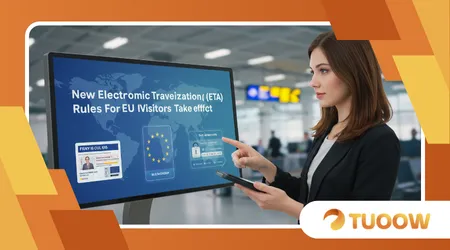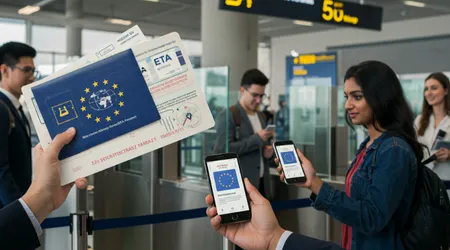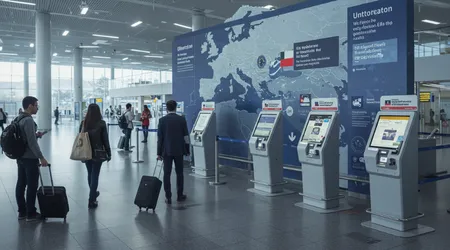New Electronic Travel Authorization (ETA) Rules for EU Visitors Take Effect

New Electronic Travel Authorization rules, effective April 2, 2025, mandate EU citizens to secure digital permits before entering the UK.
This seismic shift in border policy, aimed at bolstering security, introduces a £10 fee rising to £16 by April 9 and a digital application process.
For the 22.5 million EU visitors who flocked to the UK in 2023, this change sparks both logistical challenges and broader questions about post-Brexit travel.
Why should travelers and policymakers care?
This policy not only redefines cross-border movement but also sets a precedent for global immigration systems. Let’s unpack the implications with clarity and insight.
The UK’s decision aligns with a global trend toward pre-travel screening, mirroring systems like the U.S. ESTA.
Yet, it arrives at a delicate moment for EU-UK relations, already strained by Brexit’s fallout.
This article dives into the mechanics of the New Electronic Travel Authorization, its impact on travelers, economic ripples, and the broader geopolitical context.
From practical tips to critical analysis, we’ll explore what this means for you and the future of international travel.
Understanding the New Electronic Travel Authorization Framework
The New Electronic Travel Authorization is a digital permit linked to a traveler’s passport. It’s mandatory for visa-exempt visitors, including EU nationals, starting April 2025.
Applications opened March 5, 2025, via the UK government’s website or ETA app.
Travelers provide passport details, a facial photo, and answer security questions.
The process, costing £10 initially, takes minutes but requires planning. Approval grants multiple entries for two years or until passport expiry.
Unlike visas, the ETA doesn’t guarantee entry border officials retain final authority.
This nuance underscores the system’s focus on pre-screening for security risks. It’s a proactive measure, not a formality.
The UK government cites enhanced border security as the primary driver. A 2024 factsheet emphasized closing gaps to “prevent threats.”
++ Bird Flu Update: Latest Situation and Guidance for England
The ETA aligns with global trends, like Canada’s eTA.
Yet, the system isn’t flawless. Unofficial websites charging inflated fees have already emerged, preying on unsuspecting travelers. Sticking to official channels is crucial to avoid scams.
For EU citizens, this marks a departure from seamless travel. The requirement, excluding Irish nationals, adds friction to short stays for tourism or business. Awareness is key.

Practical Implications for EU Travelers
For EU visitors, the New Electronic Travel Authorization introduces a new pre-travel step.
Applications should be submitted three days before departure to avoid delays. No travel details are needed.
The process is straightforward but demands attention. A valid passport, email, and payment method are essential. The digital ETA links directly to the passport used.
Families must apply for each member, including children. This adds time and cost £10 per person now, £16 from April 9. Budgeting accordingly is wise.
Read more: Government Launches AI Growth Zones and Green Jobs Training
Consider Anna, a Berlin-based teacher planning a London weekend. She applies via the ETA app, uploads her photo, and pays £10. Approval arrives within hours.
Contrast this with Marco, a Milanese businessman unaware of the rule. At the airport, he’s denied boarding, missing a critical meeting. Preparation is non-negotiable.
Airlines now check ETAs before boarding, similar to U.S. ESTA protocols. Non-compliance risks being stranded, emphasizing the need for early application and awareness.
| Key ETA Details | Information |
|---|---|
| Cost | £10 (until April 9, 2025), then £16 |
| Validity | 2 years or until passport expires |
| Processing Time | Typically within 3 working days |
| Application Method | UK government website or ETA app |
| Required Documents | Valid passport, facial photo, payment |
Economic and Tourism Impacts
The New Electronic Travel Authorization could reshape UK tourism, which welcomed 22.5 million EU visitors in 2023. The added cost and process may deter spontaneous trips.
Budget airlines like easyJet remain optimistic, predicting minimal impact on demand. Yet, small increases in friction time, cos can influence traveler behavior over time.
Local businesses, from London pubs to Edinburgh tour operators, rely on EU tourists. A 5% drop in visitors could cost millions, straining post-Brexit recovery efforts.
Conversely, the ETA’s revenue £10-£16 per application could fund border upgrades. If 20 million apply annually, that’s £200-£320 million for UK coffers. A silver lining?
For travelers, the cost is modest compared to airfare. Still, for frequent visitors or large families, fees accumulate, subtly shifting perceptions of the UK as a destination.
Long-term, the ETA may normalize as global travel systems converge. The EU’s ETIAS, delayed to 2026, will impose similar requirements, creating a reciprocal dynamic.
Geopolitical and Post-Brexit Context
The New Electronic Travel Authorization underscores Brexit’s lasting impact. Free movement for EU citizens ended in 2020, but this policy cements a harder border.
It’s tempting to view the ETA as retaliatory, especially with the EU’s ETIAS looming. Yet, both systems reflect a global shift toward tighter immigration controls, not just tit-for-tat.
Critics argue the ETA alienates EU neighbors, complicating efforts to rebuild ties. A 2025 Reuters report noted UK proposals for shared values with the EU, hinting at diplomatic tensions.
Supporters, however, see it as sovereignty in action. The UK’s ability to screen entrants aligns with national security priorities, a cornerstone of Brexit’s appeal.
Think of the ETA as a digital drawbridge: it doesn’t block entry but requires a toll and inspection. This analogy captures the balance of openness and control.
The policy also raises questions about reciprocity. Will the EU’s ETIAS impose stricter rules on UK citizens? Travelers on both sides await clarity.
Navigating Challenges and Avoiding Pitfalls
Scams are a growing concern with the New Electronic Travel Authorization. Unofficial sites charge up to £80, exploiting confusion. Always use gov.uk or the official app.
Processing delays, though rare, can disrupt plans. Applying early ideally a week before travel ensures peace of mind, especially during peak seasons like summer.
Travelers with dual nationalities must use the same passport for application and entry. Mismatches trigger red flags, potentially delaying or denying entry.
For those traveling urgently, the UK allows boarding while an ETA application is pending. This flexibility, however, isn’t guaranteed and depends on airline policies.
Business travelers face unique challenges. Frequent trips mean ensuring the ETA remains valid, as passport renewals invalidate linked authorizations. Proactive planning is essential.
Education campaigns are critical. The UK government must amplify outreach to ensure EU travelers know the rules, preventing chaos at borders or airports.
The Broader Global Trend in Travel Authorization
The New Electronic Travel Authorization isn’t unique. The U.S. ESTA, Canada’s eTA, and Australia’s ETA reflect a global pivot to pre-travel screening. Security drives this trend.
The EU’s ETIAS, set for 2026, will require UK and U.S. citizens to pay €7 for Schengen access. This reciprocal system highlights a new era of controlled mobility.
These systems aim to balance security with efficiency. Digital tools and biometrics, like facial recognition, promise faster borders but raise privacy concerns.
Critics question whether ETAs truly deter threats or merely inconvenience law-abiding travelers. Data on thwarted risks is scarce, fueling skepticism about their efficacy.
Proponents argue pre-screening reduces border chaos. The UK’s plan for “contactless corridors” by late 2025 could streamline entry, assuming technology delivers.
As nations adopt similar systems, travelers must adapt. The days of spontaneous, document-free travel are fading, replaced by a structured, digital-first approach.

Looking Ahead: What’s Next for UK Travel?
The ETA’s rollout is just the beginning. By late 2025, the UK aims to fully digitize borders, integrating biometrics and automated checks. Will this redefine travel?
For EU citizens, adapting to the ETA is a short-term hurdle. Long-term, reciprocal systems like ETIAS may normalize these requirements across borders.
Travelers should stay informed. Policy tweaks fee hikes, new exemptions could emerge as the UK refines the system based on early feedback and data.
The UK’s tourism sector must innovate. Marketing campaigns emphasizing ease of ETA application could offset perceptions of added hassle, preserving visitor numbers.
Geopolitically, the ETA tests EU-UK relations. Collaborative solutions, like mutual exemptions, could ease tensions, though political will remains uncertain.
Ultimately, the ETA reflects a world prioritizing security over seamlessness. Travelers, businesses, and governments must navigate this shift with agility and foresight.
Conclusion: A New Era of Travel
The New Electronic Travel Authorization marks a pivotal moment for EU-UK travel. It’s more than a bureaucratic hurdle it’s a statement of intent.
The UK, like many nations, is redefining its borders in a digital age, balancing openness with control.
For travelers, the £10-£16 fee and online application are small prices for continued access to the UK’s cultural and economic vibrancy.
Yet, the policy’s success hinges on execution: clear communication, scam prevention, and technological reliability.
This isn’t just about forms or fees it’s about trust. Can the UK maintain its allure as a destination while enforcing stricter controls?
For the 22.5 million EU visitors of 2023, the answer matters. As the EU’s ETIAS looms, both sides face a future where travel is more structured but no less vital.
Stay informed, apply early, and embrace this new chapter. The UK’s doors remain open, but now there’s a digital key.
Frequently Asked Questions
Who needs the New Electronic Travel Authorization?
All visa-exempt visitors, including EU (except Irish), EEA, and Swiss nationals, need an ETA for UK travel from April 2, 2025.
How much does the ETA cost, and how long is it valid?
It costs £10 until April 9, 2025, then £16. It’s valid for two years or until the passport expires.
Can I travel while my ETA application is pending?
Yes, but only if the airline allows. It’s safer to apply at least three days before travel.
Where should I apply to avoid scams?
Use only the official UK government website (gov.uk) or the UK ETA app to apply securely.
Does the ETA guarantee entry to the UK?
No, it authorizes travel, but UK border officials make the final decision on entry.
